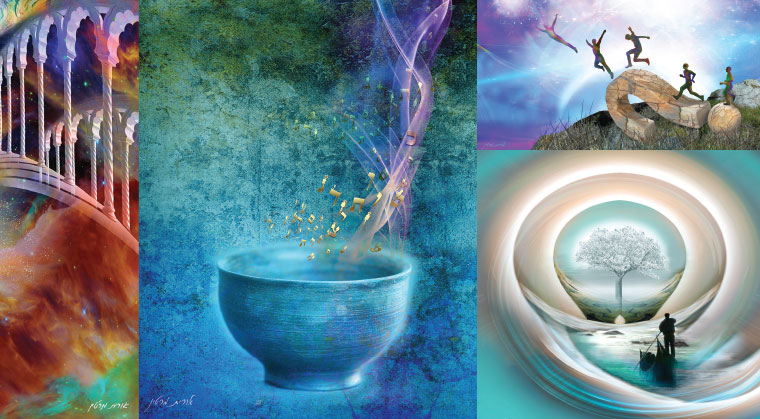Shades of Spirit

How can you express, in concrete media, the longing of a soul for its Creator? This is the question that occupies artist Orit Martin

By shifting the definitions of beauty and ugliness, Orit felt that modern art was moving her away from her instinctive grasp of spirituality: If beauty, which we connect with spiritual accomplishment, is spurned, then what do we value?
A
nger or strong emotion can be expressed by blotches of reds and oranges. Tranquility can be communicated through shades of blue. But how can you express, in concrete media, the longing of a soul for its Creator?
This is the question that occupies artist Orit Martin as she creates her unique pictures. She thinks of her art as an “invitation to associate with your soul.” And her work is distinguished by its contrasts. Juxtaposed upon the canvas are diametric opposites: life and death, the physical world and the spiritual, tranquility and turmoil.
Orit’s art resonates with people around the world, and her pictures hang in homes in Israel, Europe, the US, and even China. While her primary gallery — a place of bright white walls and breathtaking color — is in Har Nof, Orit regularly exhibits her work across the world.
Who is the woman behind these intriguing works?
Behind the Curtain
“This is me,” Orit says, pointing to the small child in the painting. The child peeps behind the veil of the picture and is confronted with a dazzling cloud-filled sky. The picture whispers of the spiritual experience involved in looking beyond the confines of This World to behold a dimension of spiritual reality.
Orit was brought up in a nonreligious home in Givatayim, where intellectual pursuits were strongly encouraged. But many of Orit’s questions were shunted to the side. “‘What happens to your mind and heart when you die?’ I asked. ‘What’s the purpose of us being here in the world?’ Instead of getting answers, I was made to feel alien by the people around me.”
A major in philosophy (alongside a minor in art) enabled Orit to delve into the works of the greatest philosophers, both ancient and contemporary, and discover their insights into the working of the human mind. “To my great disappointment, there was no discussion of the human soul,” Orit says. Any answers she did receive were dissatisfying.
Orit decided to throw herself into her art, reasoning that even if she didn’t know why she had been put on this planet, her art would ensure her some level of immortality. But the more Orit invested in her art, the deeper she felt that it wasn’t the answer to her questions.
Modern art confounded her. Defying the definitions of beauty — modern art could be ugly and disturbing — and throwing off the harmony of color and symmetry, what was left?
“This wasn’t something that could answer my thirst for spirituality, I realized. In fact, it would only distance me from what I was searching for.” By shifting the definitions of beauty and ugliness, Orit felt that modern art was moving her away from her instinctive grasp of spirituality: If beauty, which we connect with spiritual accomplishment, is spurned, then what do we value? Not only that, but the recent trends, in which anything goes — and where a steel sculpture of an orange balloon dog (produced by Jeff Koons) can be sold for millions of dollars — do nothing to uplift a person or deepen his perspective on life or the world.
Secrets
It sounds like a strange subject for a picture: a child and a grave. In Secrets a child stands over a grave in the forest, streams of warm yellow light illuminating the scene. He peers into the grave. And yet, the grave is not filled with clods of earth; it is merely a hole from which we see the beautiful blue of the sky along with tranquil clouds.
“It takes a child to see something different from what is expected,” Orit comments. Indeed, it was the child inside Orit — perpetually curious, and unusually open to new experiences — that was profoundly moved when she heard an account of someone who had undergone a near death experience. “These experiences were authenticated, for afterward, the person could recount doctors’ conversations.”
At last, Orit had found proof that even when life ended, a level of existence — soul existence — continued. She read voraciously about these experiences. “One of the things that struck me was that the vast majority of these experiences were so beautiful. They spoke of light and joy and a feeling of being encompassed by love.”
Oops! We could not locate your form.












